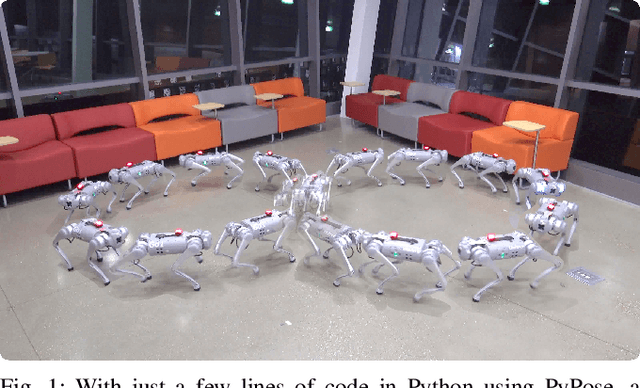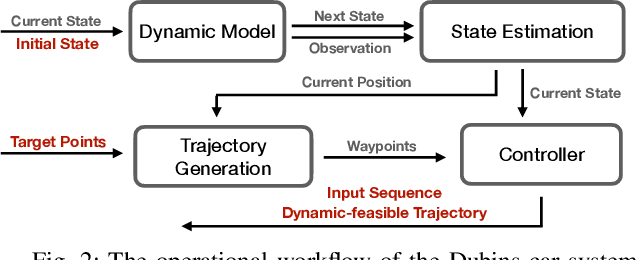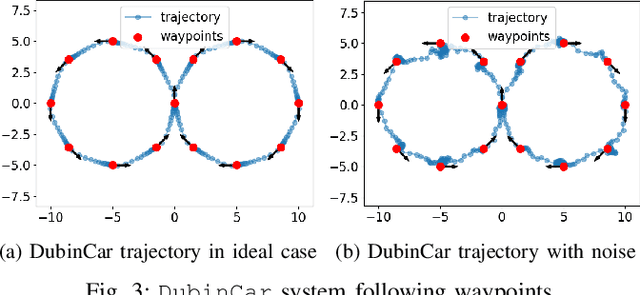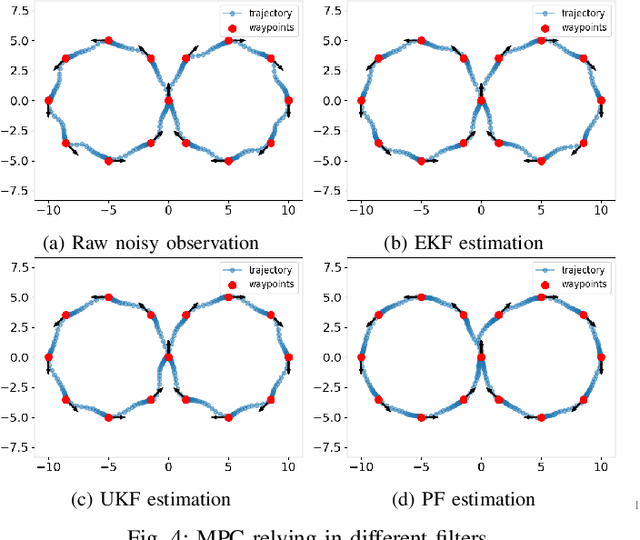Karthik Dantu
Graphite: A GPU-Accelerated Mixed-Precision Graph Optimization Framework
Sep 30, 2025Abstract:We present Graphite, a GPU-accelerated nonlinear graph optimization framework. It provides a CUDA C++ interface to enable the sharing of code between a realtime application, such as a SLAM system, and its optimization tasks. The framework supports techniques to reduce memory usage, including in-place optimization, support for multiple floating point types and mixed-precision modes, and dynamically computed Jacobians. We evaluate Graphite on well-known bundle adjustment problems and find that it achieves similar performance to MegBA, a solver specialized for bundle adjustment, while maintaining generality and using less memory. We also apply Graphite to global visual-inertial bundle adjustment on maps generated from stereo-inertial SLAM datasets, and observe speed ups of up to 59x compared to a CPU baseline. Our results indicate that our solver enables faster large-scale optimization on both desktop and resource-constrained devices.
Active Illumination Control in Low-Light Environments using NightHawk
Jun 05, 2025Abstract:Subterranean environments such as culverts present significant challenges to robot vision due to dim lighting and lack of distinctive features. Although onboard illumination can help, it introduces issues such as specular reflections, overexposure, and increased power consumption. We propose NightHawk, a framework that combines active illumination with exposure control to optimize image quality in these settings. NightHawk formulates an online Bayesian optimization problem to determine the best light intensity and exposure-time for a given scene. We propose a novel feature detector-based metric to quantify image utility and use it as the cost function for the optimizer. We built NightHawk as an event-triggered recursive optimization pipeline and deployed it on a legged robot navigating a culvert beneath the Erie Canal. Results from field experiments demonstrate improvements in feature detection and matching by 47-197% enabling more reliable visual estimation in challenging lighting conditions.
Detailed Evaluation of Modern Machine Learning Approaches for Optic Plastics Sorting
May 22, 2025Abstract:According to the EPA, only 25% of waste is recycled, and just 60% of U.S. municipalities offer curbside recycling. Plastics fare worse, with a recycling rate of only 8%; an additional 16% is incinerated, while the remaining 76% ends up in landfills. The low plastic recycling rate stems from contamination, poor economic incentives, and technical difficulties, making efficient recycling a challenge. To improve recovery, automated sorting plays a critical role. Companies like AMP Robotics and Greyparrot utilize optical systems for sorting, while Materials Recovery Facilities (MRFs) employ Near-Infrared (NIR) sensors to detect plastic types. Modern optical sorting uses advances in computer vision such as object recognition and instance segmentation, powered by machine learning. Two-stage detectors like Mask R-CNN use region proposals and classification with deep backbones like ResNet. Single-stage detectors like YOLO handle detection in one pass, trading some accuracy for speed. While such methods excel under ideal conditions with a large volume of labeled training data, challenges arise in realistic scenarios, emphasizing the need to further examine the efficacy of optic detection for automated sorting. In this study, we compiled novel datasets totaling 20,000+ images from varied sources. Using both public and custom machine learning pipelines, we assessed the capabilities and limitations of optical recognition for sorting. Grad-CAM, saliency maps, and confusion matrices were employed to interpret model behavior. We perform this analysis on our custom trained models from the compiled datasets. To conclude, our findings are that optic recognition methods have limited success in accurate sorting of real-world plastics at MRFs, primarily because they rely on physical properties such as color and shape.
You Only Crash Once v2: Perceptually Consistent Strong Features for One-Stage Domain Adaptive Detection of Space Terrain
Jan 23, 2025



Abstract:The in-situ detection of planetary, lunar, and small-body surface terrain is crucial for autonomous spacecraft applications, where learning-based computer vision methods are increasingly employed to enable intelligence without prior information or human intervention. However, many of these methods remain computationally expensive for spacecraft processors and prevent real-time operation. Training of such algorithms is additionally complex due to the scarcity of labeled data and reliance on supervised learning approaches. Unsupervised Domain Adaptation (UDA) offers a promising solution by facilitating model training with disparate data sources such as simulations or synthetic scenes, although UDA is difficult to apply to celestial environments where challenging feature spaces are paramount. To alleviate such issues, You Only Crash Once (YOCOv1) has studied the integration of Visual Similarity-based Alignment (VSA) into lightweight one-stage object detection architectures to improve space terrain UDA. Although proven effective, the approach faces notable limitations, including performance degradations in multi-class and high-altitude scenarios. Building upon the foundation of YOCOv1, we propose novel additions to the VSA scheme that enhance terrain detection capabilities under UDA, and our approach is evaluated across both simulated and real-world data. Our second YOCO rendition, YOCOv2, is capable of achieving state-of-the-art UDA performance on surface terrain detection, where we showcase improvements upwards of 31% compared with YOCOv1 and terrestrial state-of-the-art. We demonstrate the practical utility of YOCOv2 with spacecraft flight hardware performance benchmarking and qualitative evaluation of NASA mission data.
MARs: Multi-view Attention Regularizations for Patch-based Feature Recognition of Space Terrain
Oct 07, 2024Abstract:The visual detection and tracking of surface terrain is required for spacecraft to safely land on or navigate within close proximity to celestial objects. Current approaches rely on template matching with pre-gathered patch-based features, which are expensive to obtain and a limiting factor in perceptual capability. While recent literature has focused on in-situ detection methods to enhance navigation and operational autonomy, robust description is still needed. In this work, we explore metric learning as the lightweight feature description mechanism and find that current solutions fail to address inter-class similarity and multi-view observational geometry. We attribute this to the view-unaware attention mechanism and introduce Multi-view Attention Regularizations (MARs) to constrain the channel and spatial attention across multiple feature views, regularizing the what and where of attention focus. We thoroughly analyze many modern metric learning losses with and without MARs and demonstrate improved terrain-feature recognition performance by upwards of 85%. We additionally introduce the Luna-1 dataset, consisting of Moon crater landmarks and reference navigation frames from NASA mission data to support future research in this difficult task. Luna-1 and source code are publicly available at https://droneslab.github.io/mars/.
PANOS: Payload-Aware Navigation in Offroad Scenarios
Sep 25, 2024



Abstract:Nature has evolved humans to walk on different terrains by developing a detailed understanding of their physical characteristics. Similarly, legged robots need to develop their capability to walk on complex terrains with a variety of task-dependent payloads to achieve their goals. However, conventional terrain adaptation methods are susceptible to failure with varying payloads. In this work, we introduce PANOS, a weakly supervised approach that integrates proprioception and exteroception from onboard sensing to achieve a stable gait while walking by a legged robot over various terrains. Our work also provides evidence of its adaptability over varying payloads. We evaluate our method on multiple terrains and payloads using a legged robot. PANOS improves the stability up to 44% without any payload and 53% with 15 lbs payload. We also notice a reduction in the vibration cost of 20% with the payload for various terrain types when compared to state-of-the-art methods.
l-dyno: framework to learn consistent visual features using robot's motion
Oct 10, 2023



Abstract:Historically, feature-based approaches have been used extensively for camera-based robot perception tasks such as localization, mapping, tracking, and others. Several of these approaches also combine other sensors (inertial sensing, for example) to perform combined state estimation. Our work rethinks this approach; we present a representation learning mechanism that identifies visual features that best correspond to robot motion as estimated by an external signal. Specifically, we utilize the robot's transformations through an external signal (inertial sensing, for example) and give attention to image space that is most consistent with the external signal. We use a pairwise consistency metric as a representation to keep the visual features consistent through a sequence with the robot's relative pose transformations. This approach enables us to incorporate information from the robot's perspective instead of solely relying on the image attributes. We evaluate our approach on real-world datasets such as KITTI & EuRoC and compare the refined features with existing feature descriptors. We also evaluate our method using our real robot experiment. We notice an average of 49% reduction in the image search space without compromising the trajectory estimation accuracy. Our method reduces the execution time of visual odometry by 4.3% and also reduces reprojection errors. We demonstrate the need to select only the most important features and show the competitiveness using various feature detection baselines.
PyPose v0.6: The Imperative Programming Interface for Robotics
Sep 22, 2023



Abstract:PyPose is an open-source library for robot learning. It combines a learning-based approach with physics-based optimization, which enables seamless end-to-end robot learning. It has been used in many tasks due to its meticulously designed application programming interface (API) and efficient implementation. From its initial launch in early 2022, PyPose has experienced significant enhancements, incorporating a wide variety of new features into its platform. To satisfy the growing demand for understanding and utilizing the library and reduce the learning curve of new users, we present the fundamental design principle of the imperative programming interface, and showcase the flexible usage of diverse functionalities and modules using an extremely simple Dubins car example. We also demonstrate that the PyPose can be easily used to navigate a real quadruped robot with a few lines of code.
DIOR: Dataset for Indoor-Outdoor Reidentification -- Long Range 3D/2D Skeleton Gait Collection Pipeline, Semi-Automated Gait Keypoint Labeling and Baseline Evaluation Methods
Sep 21, 2023Abstract:In recent times, there is an increased interest in the identification and re-identification of people at long distances, such as from rooftop cameras, UAV cameras, street cams, and others. Such recognition needs to go beyond face and use whole-body markers such as gait. However, datasets to train and test such recognition algorithms are not widely prevalent, and fewer are labeled. This paper introduces DIOR -- a framework for data collection, semi-automated annotation, and also provides a dataset with 14 subjects and 1.649 million RGB frames with 3D/2D skeleton gait labels, including 200 thousands frames from a long range camera. Our approach leverages advanced 3D computer vision techniques to attain pixel-level accuracy in indoor settings with motion capture systems. Additionally, for outdoor long-range settings, we remove the dependency on motion capture systems and adopt a low-cost, hybrid 3D computer vision and learning pipeline with only 4 low-cost RGB cameras, successfully achieving precise skeleton labeling on far-away subjects, even when their height is limited to a mere 20-25 pixels within an RGB frame. On publication, we will make our pipeline open for others to use.
Fast Decision Support for Air Traffic Management at Urban Air Mobility Vertiports using Graph Learning
Aug 17, 2023



Abstract:Urban Air Mobility (UAM) promises a new dimension to decongested, safe, and fast travel in urban and suburban hubs. These UAM aircraft are conceived to operate from small airports called vertiports each comprising multiple take-off/landing and battery-recharging spots. Since they might be situated in dense urban areas and need to handle many aircraft landings and take-offs each hour, managing this schedule in real-time becomes challenging for a traditional air-traffic controller but instead calls for an automated solution. This paper provides a novel approach to this problem of Urban Air Mobility - Vertiport Schedule Management (UAM-VSM), which leverages graph reinforcement learning to generate decision-support policies. Here the designated physical spots within the vertiport's airspace and the vehicles being managed are represented as two separate graphs, with feature extraction performed through a graph convolutional network (GCN). Extracted features are passed onto perceptron layers to decide actions such as continue to hover or cruise, continue idling or take-off, or land on an allocated vertiport spot. Performance is measured based on delays, safety (no. of collisions) and battery consumption. Through realistic simulations in AirSim applied to scaled down multi-rotor vehicles, our results demonstrate the suitability of using graph reinforcement learning to solve the UAM-VSM problem and its superiority to basic reinforcement learning (with graph embeddings) or random choice baselines.
 Add to Chrome
Add to Chrome Add to Firefox
Add to Firefox Add to Edge
Add to Edge